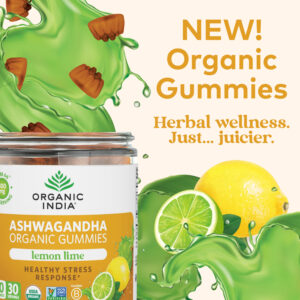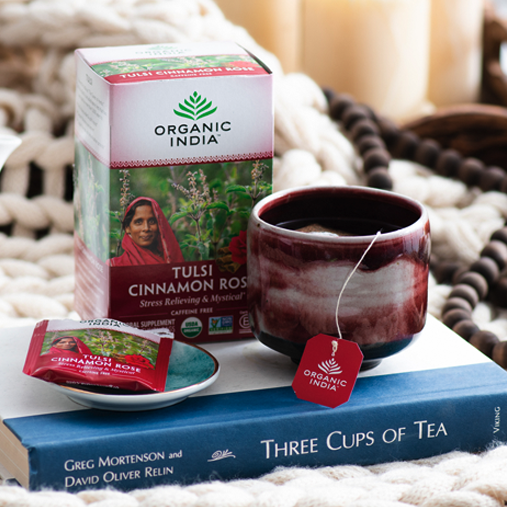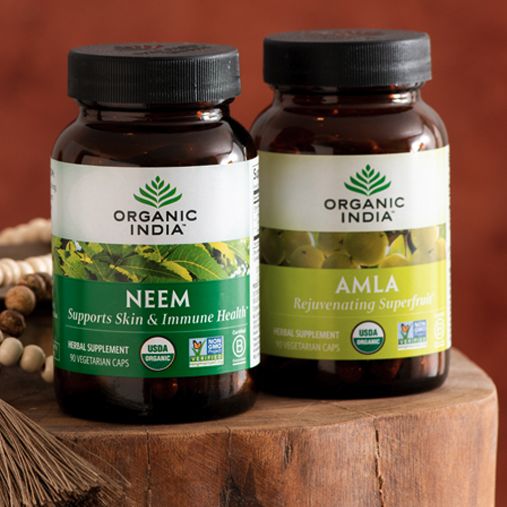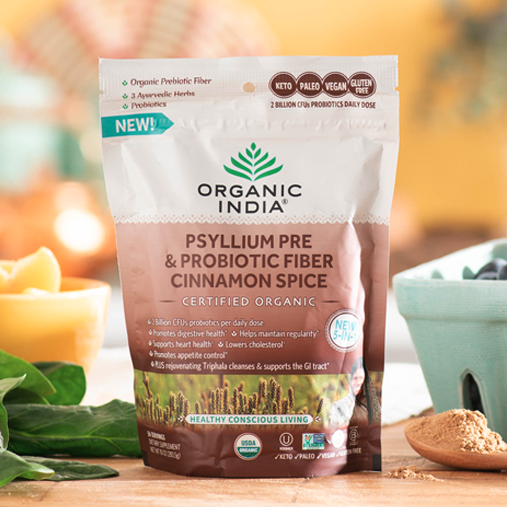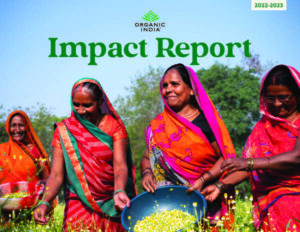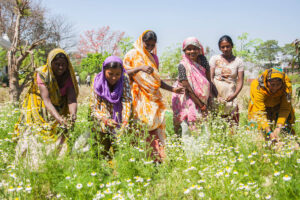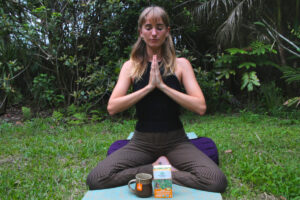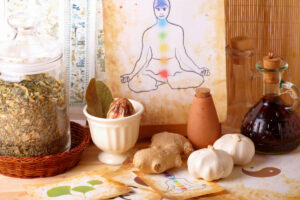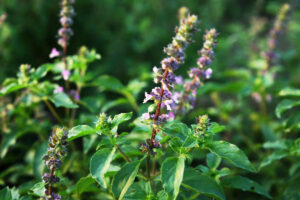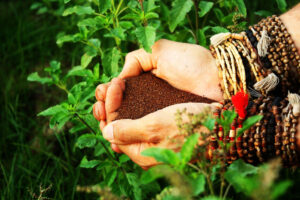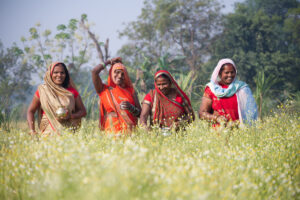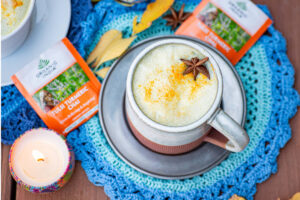Ayurveda has a rich history of using traditional herbs for beauty care, including skin, hair, nails, and anti-aging rituals.
Gotu Kola, also known as Indian Pennywort, is one such herb that boasts impressive skin care benefits for nearly all skin types.
In this article, we’ll explore the benefits of Gotu Kola for skin based on research and Ayurvedic principles, how to use it, plus fun recipes for making your own Gotu Kola skin care products.
Contents
- What is Gotu Kola?
- 6 Gotu Kola Benefits for Skin
- DIY Skin Care Recipes
- Gotu Kola Supplements
- Gotu Kola for Skin FAQ
What Is Gotu Kola?
Gotu Kola is also known as Indian Pennywort and Centella Asiatica. However, its reputation as “the herb of longevity” speaks to its beauty and skin care benefits.
Gotu Kola belongs to the parsley family and is a:
- Tridoshic (benefits all doshas),
- Adaptogen (a type of herb that increases stress resilience),
- Nootropic (an herb for brain health)
- And a Rasayana (a rejuvenator) herb
It has numerous traditional applications for health, including for stress, cardiovascular function, emotional well-being, brain health, female genitourinary function, and the absence of menstruation, to name but a few.
For beauty purposes, Gotu Kola is widely used in Ayurveda and Traditional Chinese Medicine and has been studied to promote inner and outer beauty, including strengthening and coloring hair, as well as hydrating, clearing, calming, and soothing the skin.
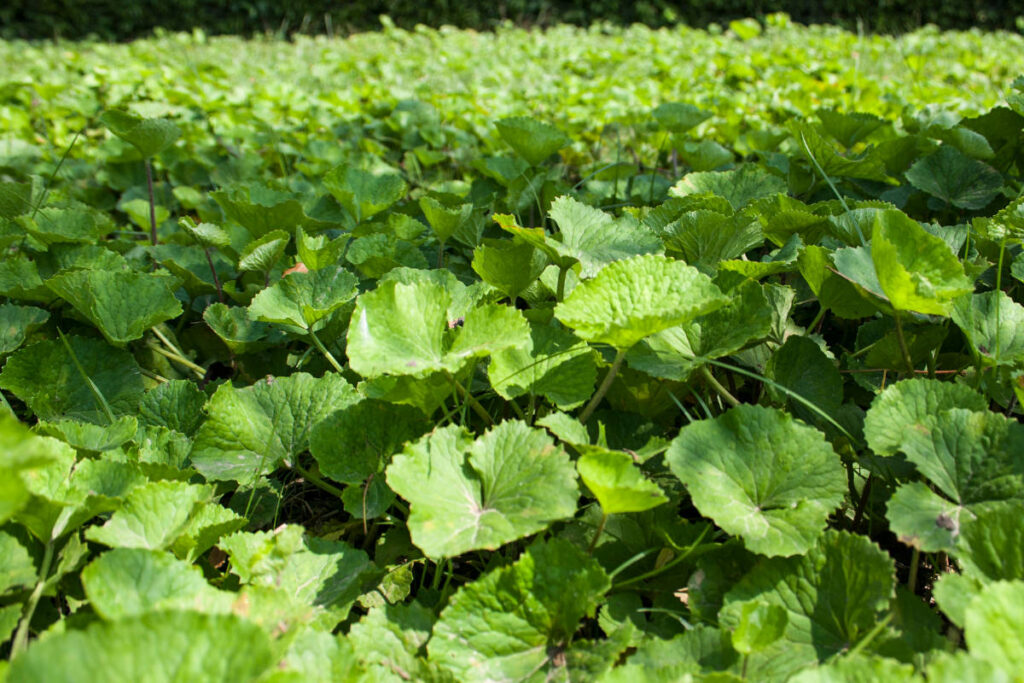
6 Benefits of Gotu Kola For Skin
Gotu Kola’s active plant compounds, including antioxidant properties, vitamins, and minerals, can offer numerous benefits for all skin types.
It is most commonly recommended for dry skin, aging skin, or irritated/inflamed skin.
The following are six examples of how Gotu Kola benefits skin health.
1. Help Slow the Signs of Aging
Gotu Kola has long been recognized as “the herb of longevity” in Ayurveda and is recommended to promote a smooth aging process for body, mind, and spirit.
This also translates to skin aging.
Studies have revealed several active plant compounds in Gotu Kola that may help slow the signs of skin aging by promoting elasticity, collagen production, hydration, normal regeneration, and to maintain already healthy inflammatory response.
Gotu Kola is also hydrating, which can help plump the skin and reduce the appearance of fine lines and wrinkles.
2. Gotu Kola Reduces Stress
Stress is one of the primary causes of skin concerns, including premature, skin imperfections, irritation, redness, and other issues.
You’ve probably experienced this first-hand: a stressful event or season comes along and suddenly your skin’s a mess.
Stress is inevitable.
However, adaptogens and rasayanas, such as Gotu Kola, can enhance our resilience to stress while promoting a state of calm focus, all of which help minimize the wear and tear on the skin.
For stress, Gotu Kola is best taken internally, such as a supplement, tea or latte. You can also use it topically to help address any stress-related skin issues—a one-two punch!
3. May Help Soothe Skin Irritation and Scarring
Gotu Kola is considered a cooling herb in Ayurveda and is used to help soothe burnt, damaged or irritated skin.
Its naturally occurring antioxidant properties, with tannins and polyphenols, as well as triterpenoids (plant compounds that contribute to the plant’s self-defense), also make it helpful for soothing minor skin irritations, rashes, and redness.
In Ayurveda, it’s traditionally used to reduce scarring and stretch marks, as well as for wound healing; however, more research is needed to validate these effects.
We’ll share recipes for soothing Gotu Kola masks and facial packs in subsequent sections.
4. Gotu Kola Beholds Skin-Supportive Nutrients
In India and other parts of Asia, Gotu Kola is used in culinary dishes as a nutrient-dense leafy green vegetable.
In its whole leafy form, some of its skin-supportive nutrients include:
- Vitamin C
- B vitamins
- Vitamin K
- Antioxidants
- Fiber
- And various minerals like iron and selenium
Like other leafy greens, Gotu Kola is also beneficial for the organs of detoxification and elimination, such as the liver and digestive tract, which can impact the skin’s clarity, resilience, and healthy appearance.
You can find Gotu Kola greens at international markets to get the full spectrum of nutritional benefits. For robust bioactive action, you can opt to take them as a supplement or tea, or try these Gotu Kola recipes to promote beauty from the inside out:
- Gotu Kola Granola (vegan, oil-free)
- Blueberry Brain-Boosting Smoothie with Gotu Kola
- Berry Cacao Mood-Boosting Smoothie with Tulsi and Bacopa
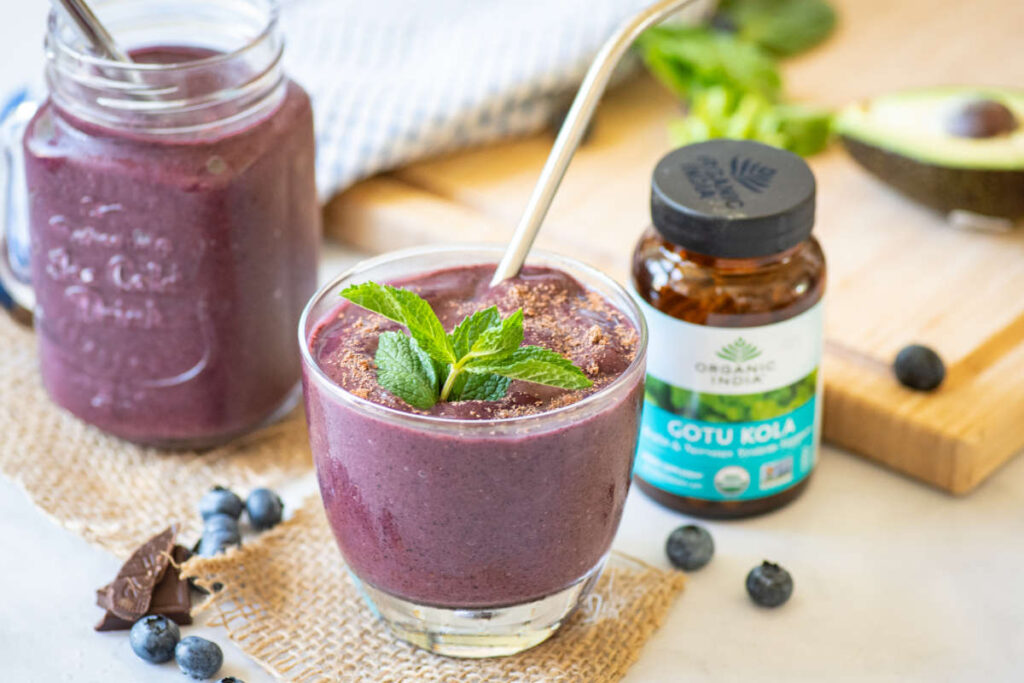
5. Gotu Kola Is Moisturizing
Gotu Kola has long been infused into oils and ghee to help with skin and hair hydration.
Research also suggests the plant compound madecassoside, a triterpene, possesses hydrating properties and supports normal skin barrier function.
Gotu Kola can be found in various Ayurvedic moisturizing oils, lotions, and creams, or you can make your own using the recipe in the next section.
6. May Help Clear Skin
Traditional use and some research suggest Gotu Kola’s active plant compounds, such as triterpenes and aglycones, specifically the triterpene madecassoside, may help with occasional skin imperfections.
This could be attributed to many of Gotu Kola’s properties, including its antioxidant properties, which support an already healthy inflammatory response, its adaptogenic nature, which helps reduce stress, its cooling nature, and its potentially beneficial effects on the dermal microbiome and skin barrier.
Plus, as you learned previously, Gotu Kola is hydrating, which can help balance oily or combination skin.
Gotu Kola can be taken internally or used as a spot treatment for problem areas.
For more details, see the DIY Gotu Kola Mask recipe below.
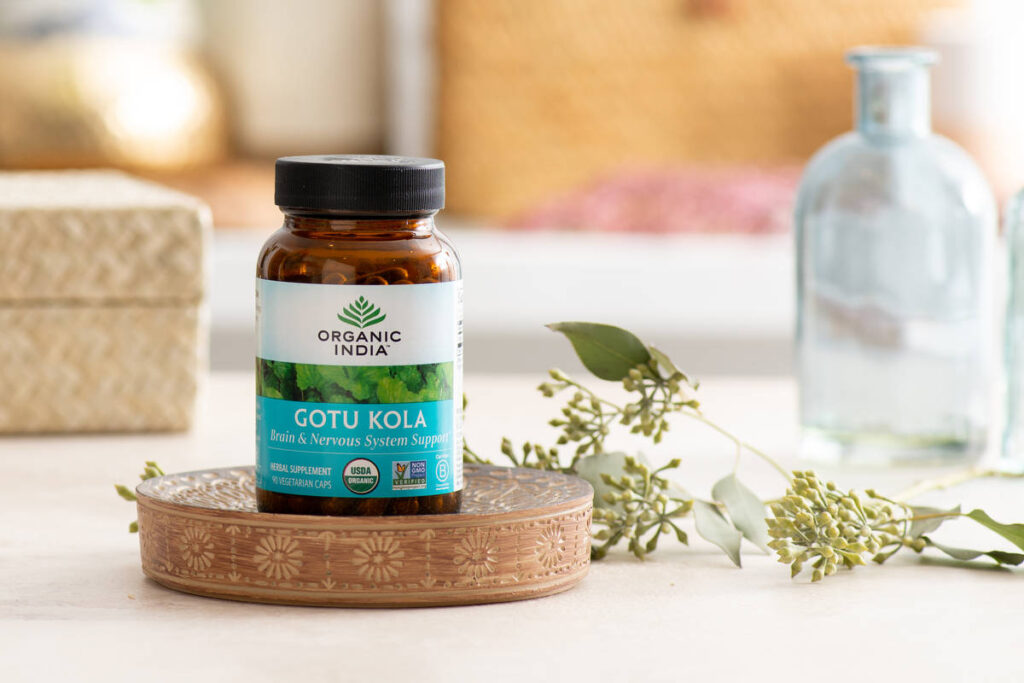
How To Use Gotu Kola for Skin Care
Gotu Kola may be recommended as a supplement and/or topical application for skincare.
You can find Ayurvedic products with Gotu Kola, or make your own using Gotu Kola powder, as outlined in the following recipes.
Gotu Kola Hydrating Facial Mask
Ingredients:
- 1 Tablespoon Gotu Kola Powder (approx. 4 capsules)
- 2 Tablespoons water, yogurt, honey, rosewater, or aloe vera
- Important: Spot test before using
How To Make & Use:
- Add your preferred liquid into a small bowl
- Twist open your Gotu Kola capsules and empty the contents into the same bowl
- Mix well until you form a smooth paste
- Apply evenly to face, avoiding the eye area
- Leave for 15 minutes
- Rinse thoroughly with warm water and pat your skin dry
DIY Gotu Kola Facial Oil
Facial oils have finally gained popularity in the West and are incredibly easy to make at home using your favorite herbs. Facial oil can benefit all skin types, especially those that tend to be in need of moisture to balance its oil production. It can be used as a facial or body moisturizer or for oil cleansing.
Ingredients:
- 8 tablespoons Gotu Kola powder or ground herb
- 1/2 cup oil of choice—choose one or combine 2 or 3 based on your skin type:
- Rosehip oil (mature, oily, or acne-prone skin)
- Jojoba oil (all skin types)
- Sesame oil (dry or normal skin)
- Grapeseed oil (oily or acne-prone skin)
- Hempseed oil (all skin types, great for acne-prone skin)
- Olive oil (dry or normal skin)
- Optional: 1-2 capsules of vitamin E (acts as a natural preservative)
How to make:
- Fill a slow cooker about halfway full with water and set it to low.
- Combine the oil (s) with the herbs in a pint-sized mason jar or other heatproof container.
- Seal the jar well and place it in the water in the slow cooker.
- Allow to cook on low for 8-12 hours or overnight, to infuse the oil.
- Carefully lift the oil from the slow cooker using slip-proof tongs, canning tongs, or oven mitts.
- Allow to cool slightly so you can handle it without burning yourself (the jar will be hot but not scalding).
- Using a fine mesh strainer, strain the herbs out of the oil into another mason jar or storage container. Press on the herbs to extract as much as possible.
- Store in an amber or dark-colored dropper bottle for easy use.
- You can use this immediately, applying a small amount to your face (1-4 drops) and massaging it in. Use once or twice daily.

How To Take Gotu Kola as a Supplement
Check with your practitioner for supplement recommendations. As a general starting point, Organic India’s Gotu Kola Herbal Supplement contains 700 mg of Gotu Kola per capsule, with a recommended daily dose of 2 capsules.
This is typically sufficient to promote skin health and provide additional stress relief and brain health benefits.
However, an Ayurvedic practitioner may recommend a greater or lesser dosage depending on your unique presentation.
Shop Organic India’s Gotu Kola Supplements
Organic India is one of the leading growers and distributors of regeneratively grown organic herbs, including Gotu Kola.
Our Gotu Kola supplements include pure Gotu Kola and herbal blends such as Memory, Joy, Organic Chocolate Moringa Latte, and Peaceful Sleep.
Our Gotu Kola capsules can be taken internally or used to create your own Gotu Kola skin or haircare products.
Shop Organic India’s Gotu Kola products here.
Learn more about the benefits of Ayurvedic herbs for beauty in:
- Gotu Kola For Hair: Ayurvedic Secrets and Treatments
- DIY Herbal Face Mask For Dry Skin: 3 Options
- Ashwagandha for Hair: A Comprehensive Guide
FAQs
We’ve covered a lot about Gotu Kola for skin, but there’s always more to learn! Here we answer some FAQs.
Is Gotu Kola suitable for your face?
Yes, Gotu Kola can benefit all skin types and offers hydrating, soothing and cooling properties. As mentioned previously, it may also be helpful for breakouts. Always do a small patch test to see how your skin responds to Gotu Kola.
How to Use Gotu Kola for Healthy Aging?
Gotu Kola, also known as “the herb of longevity,” is highly versatile and can offer benefits for healthy aging when taken internally, such as in a supplement or as a green vegetable, or applied topically.
If you’re interested in healthy aging benefits beyond just skincare, a supplement can offer broad-spectrum benefits for cognitive function, immunity, perimenopause, menopausal symptoms, emotional well-being, sleep, and more.
It can also be used exclusively topically to help soften the signs of aging.
Or you can do both for maximum benefit.
Consult your Ayurvedic practitioner for personalized recommendations.
Related reading: Gotu Kola: An Ayurvedic Gem for Mind, Body, and Soul
Does Gotu Kola tighten skin?
Gotu Kola applied topically may have a tightening effect on certain skin types thanks to its hydrating and antioxidant properties.
However, it will take time to notice results. Be sure to use it consistently over a period of weeks or months for optimal results.
